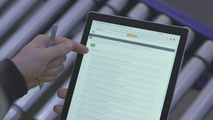Ahead of our BCarm Academy on 1st November, we explore how digitalisation can be a game-changer for Health and Safety.
Let's start with the fact that the H&S Management process has some inherent challenges such as;
- There's a need for an audit trail of activity to demonstrate compliance, in case of prosecution or employers liability claims.
- Maintaining Safety is made up of many ongoing activities.
- These activities frequently involve many different components.
- It requires Engagement at every level of an organisation, to which there may be varying degrees of buy-in.
- It's reliance on Lag Metrics, such as accident statistics as a measure of performance.
- And, if you do it well, what have you got to show for it!
These challenges can be compounded if the systems used to manage this are themselves access, interrogate or report on.
Watch this 2-minute explainer video on how Health and Safety meets Business Improvement |
|
We recently conducted a industry-wide survey on Digitisation of Health and Safety and one of the questions we asked was "What is the format of your current H&S management system?" As can be seen below there is still a strong emphasis on electronic (Word/Excel/SharePoint); digital is still in its early stages of adoption.

So given the challenges, can digitisation make a difference? The answer is most certainly yes, provided we are talking about a digital management system and not just digital records.
Here's how and why a digital risk management system can address this.
- A digital risk management system will replicate your organisational structure allowing access to be defined and management information to be interrogated by business area - the importance of this can't be over-emphasised - if you want to set KPI's against areas of responsibility, how do you measure it.
- An audit trail is created automatically with every action within the digital risk management system and is interrogate-able (time saved on auditing activity can be re-focused in management activity).
- A digital risk management system can be accessed both onsite and remotely (no excuses).
- Multiple individuals can access the system with different permissions and access levels allowing wider engagement in the safety process.
- A system will schedule, manage and create visibility of ongoing activity, allowing the process to become "how we do things around here".
In our recent industry-wide survey, 80% of businesses are either discussing it now or plan to do so in the next 12 months.
- Management alerts can send out notifications when pre-set events occur/don't occur. This instant visibility creates the opportunity for a management response - "this is important to us".
- Process steps can be removed reducing organisational friction and cost. It will also help with dis-engagement caused by "this is too much hard work". It also creates opportunity for automation and workflows.
- Lead performance metrics can be delivered to allow pre-emptive action and strategic decision-making as well as individual and business unit performance against KPI's and Objectives.
In our survey, we asked, "What are the 3 top deliverables from a digital risk management system?"

But change brings its own risks, so we were asked, "What would be the biggest concerns if implementing a digital risk management system?" Introducing new systems to the team was the biggest concern, followed by the time involved.
For us, there were no surprises that the human factor came out on top and this is consistent with our experience of implementing BCarm; this is the key consideration for us in any system implementation.
So, can digitalisation make a difference?
The answer is most certainly yes. It provides a robust platform to build culture and behaviour and addresses many of the inherent challenges within the safety process. But, and it's a big but, implementation and engagement are absolutely critical.
Another advantage of digitalisation is accessibility, both online and remotely. The more people can engage in the Health and Safety process, the more likely it is to be completed; what's easy, get done!
Digitalisation can be difficult to quantify, but our customers tell us that adopting a digital platform rather than relying on Word, Excel, or SharePoint can save each employee between £150 and £225 annually - so, a company with 50 employees, could save over £11,000.
Is digitisation of safety gaining pace?
It certainly seems that way. In our survey, 80% of businesses told us they are either discussing it now or plan to do so in the next 12 months.
More information about digitising Health and Safety.
If you're interested in finding out more, you can read how one company embarked on digitising its Health and Safety process here.
To see how this would work in your business, take a look at our Health and Safety Management System.
If you found this article useful, you may also be interested in our related insights such as












